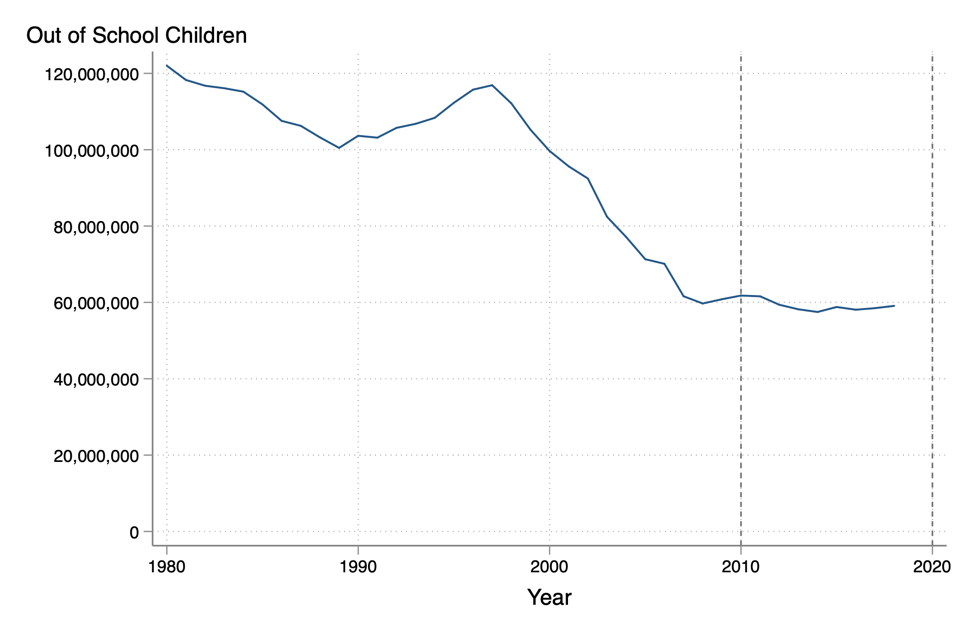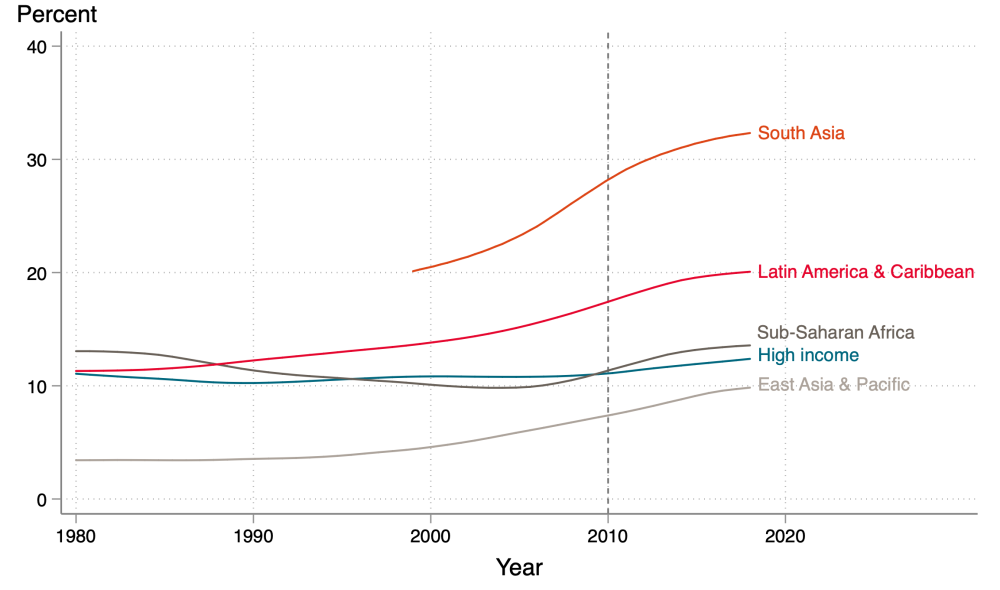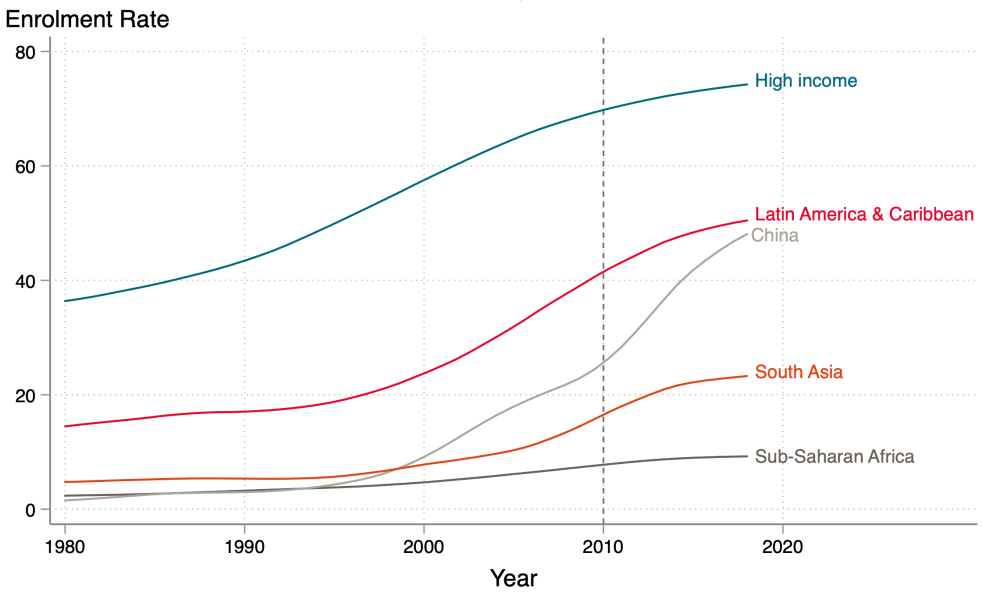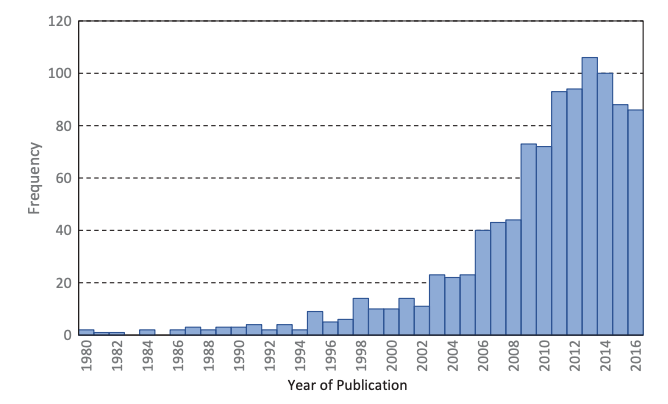The “tens” are over and it’s been quite a decade in global education. The Millennium Development Goals (MDGs) became the Sustainable Development Goals (SDGs), a learning crisis was discovered, and randomized controlled trial (RCT) and private school wars showed no signs of abating. We take a look at ten trends that shaped education policy debates this decade.
1. Universal secondary is the new universal primary
The MDGs (2000–2015) had just one goal for education—universal primary school. The SDGs (2015–2030) have ten. And, according to UNESCO, they’re way off-track. The one that’s caused most policy debate is universal secondary education. Free universal secondary education was a favoured election manifesto policy this decade, with winning parties in Ghana, Malawi, Sierra Leone, Tanzania, and elsewhere promising to massively expand access to secondary school. It’s easy to see why. Free school brings big returns for wages and health. But despite its electoral popularity, secondary enrolment in sub-Saharan Africa is still lagging way behind other regions. A big question for the new decade will be how to pay for secondary education in Africa.
Figure 1. Gross secondary enrolment.
Source: World Bank Open Data.
2. Progress on universal primary stagnated
The single MDG target was: “Ensure that, by 2015, children everywhere, boys and girls alike, will be able to complete a full course of primary schooling.” Significant gains were made: Net primary enrolment increased from 83 percent in 2000 to 91 percent in 2015 and the number of out-of-school children nearly halved, from around 100 million to 57 million during the same period. But the majority of these gains were made before 2010 and, since then, almost no progress has been made. UNESCO estimates that 59 million primary-age children were out of school at the end of 2018, 32 million of whom are girls and 32 million are in sub-Saharan Africa.
Figure 2. Primary enrolment stagnation.
Source: World Bank Open Data
3. Private schools continued to grow, but slower, and lots of people still hate them
The term “low cost private schools” was coined by Prachi Srivastava back in 2001. Before then, according to Srivastava, there was very little research or policy interest in the private schooling sector. But it quickly became a lightning rod with ideology driving much of the debate. Voices on either side tried to drown each other out with warnings of mass privatization and claims of magic bullets. DFID commissioned a rigorous review in 2014 to try—without much success—to inject some evidence into the debate (we did a quick update of the evidence in 2019).
The reality is of course a lot less dramatic. The sector grew a bit this decade, but the vast majority of kids are still enrolled in public schools. And, while private schools work better in some places for some children, they do not work better everywhere and for everyone. It’s well past time that we moved on from debating whether public schools or private schools are better.
Figure 3. Private primary school enrolment (as percentage of total primary enrolment).
Source: World Bank Open Data
4. Higher education in China expanded at a breathtaking rate
In 1998 the Chinese government announced their intention to expand higher education. From 1999 to 2009, they increased tertiary enrolment six-fold, from one million to six million students. They also raised the share of the urban labour force with a college degree by 60 percent. It didn’t stop there. By 2018, gross enrolment in tertiary education was more than 50 percent with women enrolling at higher rates than men. As college enrolment mushroomed, wage returns did not fall, a pattern reflected in rapid expansion in the UK, India, and Vietnam,
What is not clear is the extent to which higher enrolment in tertiary education has improved equality of admissions into elite institutions or competitiveness in the labour market. But this massive investment in human capital and high skilled labour is likely to foster further growth in China.
Figure 4. Gross tertiary enrolment in China and elsewhere.
Source: World Bank Open Data
5. The promise of edtech is yet to be fulfilled
Edtech has for years been hailed as a way to leapfrog failing school systems. Philanthropists and investors love it and it’s a popular policy choice for national governments. Despite the hype, it’s still a “faith-based” endeavour in many low- and middle-income countries (although we know more about what works in developed countries than we did a few years ago). We also know a bit more about what does not work, for example giving children laptops.
But there are a few exceptions, most notably Mindspark, an adaptive learning programme which showed significant effects on learning and is now being tested (and evaluated) in public schools in India. Encouragingly, there are big new efforts to address the dearth of evidence, with a new edtech research hub announced in 2019. Watch this space.
6. We discovered the learning crisis
Some were talking about poor learning decades ago, but this is the decade in which the global education community decided that learning is in crisis and should be the focus of education reform efforts. Those efforts are yet to bear much fruit. ASER played a central role in raising visibility of poor learning, conducting mass reading surveys in India since 2007. In 2008 around 53 percent of grade-five children in government schools could read a grade-two text. Ten years later, just 44 percent could.
Figure 5. Annual publications mentioning “learning crisis.”
Source: Google Scholar
Some argue that lack of clarity in SDG4.1 (the target for learning) is hindering progress. So, at the very end of the decade a new target—halving “Learning Poverty”—was introduced by the World Bank aiming to provide something more “concrete” than the SDGs for governments to aim for.
But, there are some reasons to be optimistic. Learning rose high on the agenda of global and (some) national policymakers. EGRA—the early grade reading assessment—has been used in more than 65 countries and 100 languages. A few interventions have achieved impressive outcomes and scale.
7. Media scandals forced attention on safeguarding
In early 2018, big non-governmental organizations (NGOs) dominated the headlines for all the wrong reasons. Oxfam was accused of covering up claims that senior staff paid for sex with underage girls. A few weeks later, allegations of bullying and a toxic masculine culture emerged at Save the Children. Later that year, ProPublica’s investigative report revealed rape and abuse of children by one of the founders of “More than Me.” These tragic events rightly brought safeguarding into the centre of policy conversations in global education and aid more generally. While some have been working on safety in schools for many years, not enough is known about the extent of the challenge of school-related violence nor how to prevent it.
8. Everyone loved RCTs
The use of RCTs in education expanded massively this decade. RCTs are a bit like marmite. Some (including the Nobel Prize committee) think they are changing the world, manageable pieces at a time. Others very much do not. What’s clear is that they became a lot more widespread in this last decade. A systematic review of RCTs in education research found just over a thousand unique studies between 1980 and 2016, with more than half of these produced between 2010 and 2016.
More recently, we are seeing a welcome shift to using randomized experiments at scale, not just in small, laboratory-like NGO conditions. This is where RCTs can be a truly valuable tool to policymakers thinking about system-wide interventions.
Figure 6. Number of randomized controlled trials in education completed internationally between 1980 and 2016.
Source: P. Connolly et Al.
9. Education in crisis situations became a priority
Seventy-five million children worldwide are affected by crisis. Conflicts, disasters caused by natural hazards, and pandemics keep millions of children out of school: In crisis-affected countries, school-age children are more than twice as likely to be out of school as their peers in other countries. Children affected by crisis are some of the hardest to reach and, until recently, efforts had focused on fulfilling basic needs, including shelter, food, protection, and water—only two to three percent of humanitarian funding has traditionally been earmarked for education. During this decade the rhetoric at least started to change. The 2011 Global Education Monitoring Report set out an agenda to protect the right to education during situations of conflict and crisis. And in 2016 an Overseas Development Institute (ODI) paper proposed a new fund dedicated to education in crisis situations. Education Cannot Wait was established later that year. However, it’s not yet clear if money will follow recognition of the need. The ODI paper estimated that $8.5 billion is needed each year to close the education gap for children in crisis. To date, pledges of just $500 million have been made to Education Cannot Wait and still only around two percent of humanitarian aid is spent on education.
10. The need to strengthen education systems was recognised
A former Indian federal minister of education once remarked to me “all pilots fly, but at the end of the day we just have pilots and academic papers: show me something that can reach a million schools in India.” The 2009 Global Education Monitoring Report marked a step-change: Its focus on governance shone a light on the disparities in education based on income, gender, location, and other markers, linking them to structural barriers and policies that tolerate or exacerbate inequity and fuel the transmission of poverty across generations. This was the first time a major report focused on the issue and it sparked renewed interest in improving education by strengthening education systems, a mantle that was taken up with vigour by the UK’s Department for International Development (DFID) through their investment in 2014 in the Research on Improving Systems of Education (RISE) programme.
What to expect for the coming decade?
As the proverb goes, prediction is difficult, especially about the future. But on current trends, it seems pretty clear that the world will fail to meet the (ambitious) Sustainable Development Goal on education. One reason for this is that the education aid architecture is not functioning as well as it should. With various efforts afoot to reform it, it’s likely to look quite different at the end of the decade.
On the access front it seems hard to see how the lowest-income countries will be able to mobilise sufficient resources to ensure universal access to secondary schools, either domestically or internationally. That said, prospects for rapid improvement seem better for enrolment than for learning. While enrolment has accelerated, even in some of the poorest countries in the world, improvements in learning have been much, much slower (where they have come at all). One possibility is that there will be a breakthrough in free personalised learning software that will allow for mass learning. Whilst there is a good chance of this happening eventually, it will more likely be later than sooner, perhaps between 2030 and 2040.
Education has not yet fulfilled its promise of being the great societal equalizer. While more girls are in school, gender inequality remains acute and deeply rooted in the economic, political, and social spheres in developing countries. Primary school enrolment may have increased rapidly, but intergenerational mobility is declining, not increasing. Poor children get educated in bad schools where they do not acquire basic numeracy and literacy skills while rich children attend good schools. This coming decade we optimistically think we’ll see far more attention given to the issue of education and inequality. This is important, because if what we really care about is equality of opportunity, it seems unlikely that small improvements in basic literacy and numeracy for the poorest will be enough.
This blogpost was shamelessly crowd-sourced through Twitter, so thank you to all who contributed their ideas to that thread.
Disclaimer
CGD blog posts reflect the views of the authors, drawing on prior research and experience in their areas of expertise. CGD is a nonpartisan, independent organization and does not take institutional positions.











